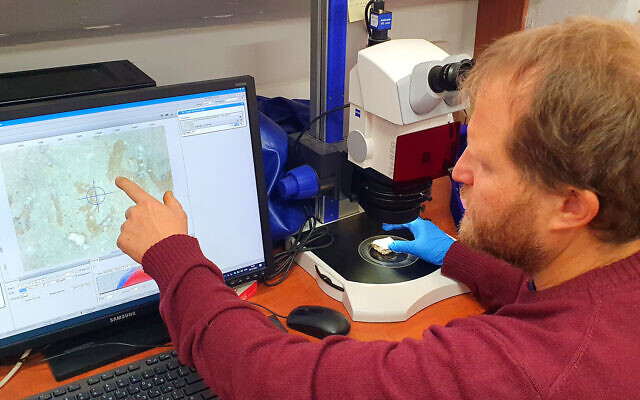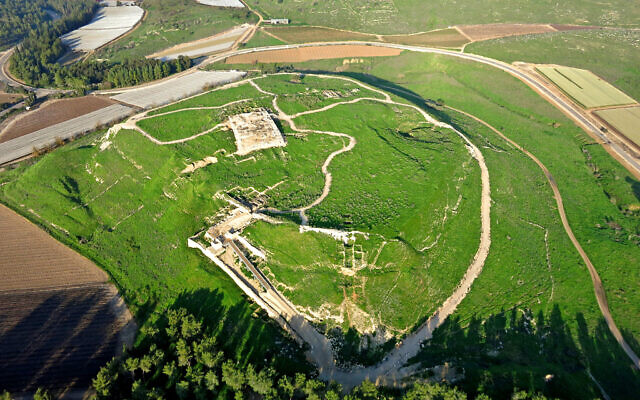A traveler in Israel’s Judean lowland recently discovered a 2,500-year-old pottery shard inscribed with the name of the Persian king Darius the Great, the father of King Ahasuerus. The Israel Antiquities Authority announced on Wednesday that this is the first discovery of an inscription bearing the name of Darius I anywhere in Israel.
King Ahasuerus is widely believed to be the Biblical Achashvarosh from the story of Purim, which Jews will celebrate the following week. The site of the find, the ancient city of Lachish, was a flourishing city and a major administrative center 2,500 years ago. The inscription is believed to be a receipt for goods received or sent.
The ostracon, a shard that was used as a writing surface, bears an Aramaic inscription that reads “Year 24 of Darius”, dating it to 498 BCE. Darius I ruled from 522–486 BCE, during which time the Persian Achaemenid Empire grew rapidly and encompassed a large area of the ancient world. But no written evidence of Darius’s rule has been found in Israel so far.
The hiker, Ilona Levy, international media adviser to President Isaac Herzog, was walking in Tel Lachish in central Israel last December when he picked up a stone that seemed to have strange markings on it. When he took a closer look, he saw that it was a piece of pottery that could be written on.
“Suddenly my heart stopped,” Levy told The Times of Israel this week.
“Immediately when I picked it up, I thought it was an elaborate prank. I thought, This can’t be real, this doesn’t really happen to people when they’re just hiking,” he said. Levy said that he looked around to see if there were cameras and that he was unknowingly being punked by a reality TV show.
But when he took a closer look, he saw that the inscription continued under a crust of filled clay, which seemed too elaborate for a fake.
“I immediately reported this to the Israel Antiquities Authority,” Levy said. “His response was that it looks real and very interesting.”

On March 1, 2023, a vessel discovered in Tel Lachish with an Aramaic inscription “Year 24 of Darius” was revealed by the Israel Antiquities Authority, dating it to 498 BCE. (Shai Holloway / IAA)
The IAA’s Saar Ganor, who oversees the excavations at Tel Lachish, came to meet Levy at the president’s residence and took the shards for further testing.
“I was still a little skeptical. I thought it was too good to be true,” Levy said. “It seemed very serendipitous, such an extraordinary discovery right under everyone’s nose.”
But a few weeks later, after the IAA had put the potsherd through several scans and laboratory tests, including at the Dead Sea Scrolls lab, Gaynor called Levy and told him that the potsherd was deemed authentic.
An article about Khuda Thekhra will be published in the Israel Antiquities Authority magazine’overcoat, Section. 110: Ancient written works (L) d.
Would you like a receipt with that?
Darius I’s son, King Hisrrhus (Ahasuerus, also known as Xerxes in Greek), followed his father in expanding the empire, ruling over much of the ancient world “from India to Kush”. [modern-day Ethiopia],” as told in the Book of Esther.
The Book of Esther, which Jews read on the holiday of Purim, tells the story of Achashvarosh’s court when the Jews of Persia were threatened by the destructive plans of Haman, Achashvarosh’s chief advisor. Queen Esther and her uncle Mordechai used their influence with the king to thwart Haman’s plans and save the Jewish people, and the holiday is often celebrated today with elaborate costumes and heavy drinking.
Levy found the ostracon in the remains of a Persian royal administration building at Tel Lachish, which was first excavated in the 1930s and has hosted hundreds of archaeologists over the decades. Archaeologists believe that the ostracon may have been an administrative note, such as a receipt for goods or their shipment.

From right to left, Yaakov Ashkenazi, Eilon Levi, and Israel Antiquities Authority archaeologist Dr. Haggai Misgaev and Saar Ganor with the shards at Tel Lachish. (Yoli Schwartz/IAA)
Lachish was in the province of Edom/Idumea, described as “beyond the river” province of the ancient Persian Empire in Ezra 4:20 and Deuteronomy 1:7. The region paid taxes to the Persian administrative system, sometimes in the form of agricultural produce.
“The British archaeological expedition excavating at Tel Lachish in the 1930s uncovered an elaborate administrative building from the Persian period, built on top of the platform of the destroyed palace-fortress of the Judean kings,” epigrapher Dr. Haggai Mishgav explained. Hebrew University of Jerusalem, one of the primary researchers of Lachish. The administrative building had elaborate halls and courtyards with grand pillared portico entrances.
Lachish was a prosperous Canaanite city in the 2nd millennium BCE, and the second most important city in the Kingdom of Judah after Jerusalem. The city appears prominently in the Old and New Testaments as the sites of battles with Joshua, Sennacherib, and Nebuchadnezzar. In the year 701 CE, the Assyrian army stormed and captured the city by constructing a massive ramp, which visitors can still climb today. army had to move 3 lakh stones to make rampExperts believe.

Experts examine the shard at the Israel Antiquities Authority’s analytical laboratory, revealed by the IAA on March 1. (Abstract Gone / IAA)
Misgao said, “Today, only the bases of the pillars remain on the mound, as the British expedition to excavate the underlying Jewish palace destroyed the remains of the elaborate Persian building.”
“Funnily enough, [the potsherd] It was right there, right next to the wooden pergola that was built for visitors,” Levy said. “It was right there, right under everyone’s noses this whole time.” Small objects sometimes get washed away by rain And unexpected discoveries are made even in the most well-excavated sites.
Tel Lachish hosts thousands of visitors each year, and a new visitor center is expected to open in the coming months.
This is not the first time Lachish has hosted the discovery of an important text. In 2015, researchers announced the discovery of some of the earliest known written Semitic letters, dating from around 1130 BCE. Hebrew University Prof. Yosef Garfinkel stated at the time, “the Canaanite city of Lachish was one of the most important centers in the world for the use of the alphabet,” and preserved the culture of using an egalitarian writing system.
Last year, archaeologists announced that they had discovered an even older inscription, one of the oldest Canaanite sentences ever found. Middle Bronze Age ivory lice comb From about 17th century BC.

An aerial view of the Tel Lachish archaeological site and Persian administrative palace. (Emil Aladjem / IAA)
the evidence is scattered all around us
Levy said that whenever he hikes to archaeological sites around Israel, he likes to lift things off the ground, on the off chance that it might lead to broken pieces of pottery or ancient debris. But he had not yet had the experience of finding anything unique.
Levy said that he and his climbing friend, Yaakov Ashkenazi, have some friendly rivalry because Levy was the one who found the shard. But Levi said that without the Ashkenazi, he would never have been able to hike to Lachish in the first place.
“It was incredibly exciting to be part of a discovery like this,” Ashkenazi told IAA. “It’s really something special, especially for someone who loves history as much as I do.”

Experts are working to examine and preserve the Darius I potsherd discovered in Tel Lachish in December 2022. (Abstract Gone / IAA)
For Purim, Levy said he considered dressing as Indiana Jones, but decided to dress as Darius I instead. He acknowledged that dressing as an ostracon would be very difficult. He also looks forward to getting back together with Ashkenazi and exploring other archaeological sites.
“The evidence of ancient Jewish history and the history of world civilizations is scattered all around us, not only in sites yet to be discovered but also in places people travel to all the time,” Levy said.
“It’s part of the fun of visiting an archaeological site – you just might find the next big find. Next time I go, I’ll definitely be more conscious of what’s around my feet, and keep my eyes firmly closed.” I will keep it on the ground.”